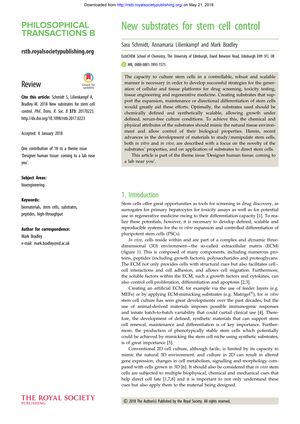New Substrates for Stem Cell Control
May 2018
in “
Philosophical Transactions of the Royal Society B
”
stem cell control stem cell expansion stem cell maintenance directional differentiation chemically defined substrates serum-free culture protein-based substrates peptide-based substrates synthetic polymer-based substrates stem cell niche cell attachment cell signaling cell migration cell proliferation cell differentiation drug screening toxicity testing tissue engineering regenerative medicine RGD-functionalized PuraMatrix neuronal differentiation tripeptide hydrogel chondrogenesis peptide hydrogels hMSC proliferation hMSC adhesion decellularized pig heart valves endothelial progenitor cell growth high-throughput screening substrate design PuraMatrix

TLDR New materials help control stem cell growth and specialization for medical applications.
The review article from May 21, 2018, focused on the development of new substrates for stem cell control, aiming to support stem cell expansion, maintenance, and directional differentiation in a controllable and scalable manner. The authors discussed the need for chemically defined substrates that mimic the natural tissue environment and allow for serum-free culture growth. They reviewed advances in protein, peptide, and synthetic polymer-based substrates, detailing their role in directing stem cell behavior and potentially overcoming the limitations of animal-derived materials. The substrates are designed to replicate the stem cell niche, providing cues for cell attachment, signaling, migration, proliferation, and differentiation, which are crucial for applications in drug screening, toxicity testing, tissue engineering, and regenerative medicine. Specific examples included RGD-functionalized PuraMatrix for neuronal differentiation, a tripeptide hydrogel for chondrogenesis, peptide hydrogels for hMSC proliferation and adhesion, and decellularized pig heart valves for endothelial progenitor cell growth. The review also mentioned high-throughput screening methods for identifying suitable substrates, emphasizing the significance of substrate design in stem cell research and the necessity for interdisciplinary collaboration in the field.

